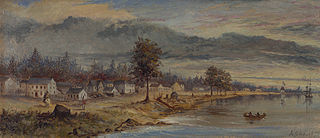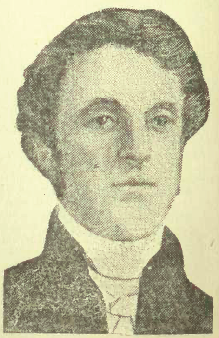Related Research Articles

The Province of Upper Canada was a part of British Canada established in 1791 by the Kingdom of Great Britain,to govern the central third of the lands in British North America,formerly part of the Province of Quebec since 1763. Upper Canada included all of modern-day Southern Ontario and all those areas of Northern Ontario in the Pays d'en Haut which had formed part of New France,essentially the watersheds of the Ottawa River or Lakes Huron and Superior,excluding any lands within the watershed of Hudson Bay. The "upper" prefix in the name reflects its geographic position along the Great Lakes,mostly above the headwaters of the Saint Lawrence River,contrasted with Lower Canada to the northeast.

York was a town and the second capital of the colony of Upper Canada. It is the predecessor to the old city of Toronto (1834–1998). It was established in 1793 by Lieutenant-Governor John Graves Simcoe as a "temporary" location for the capital of Upper Canada,while he made plans to build a capital near today's London,Ontario. Simcoe renamed the location York after Prince Frederick,Duke of York and Albany,George III's second son. Simcoe gave up his plan to build a capital at London,and York became the permanent capital of Upper Canada on February 1,1796. That year Simcoe returned to Britain and was temporarily replaced by Peter Russell.

William Lyon Mackenzie was a Scottish Canadian-American journalist and politician. He founded newspapers critical of the Family Compact,a term used to identify elite members of Upper Canada. He represented York County in the Legislative Assembly of Upper Canada and aligned with Reformers. He led the rebels in the Upper Canada Rebellion;after its defeat,he unsuccessfully rallied American support for an invasion of Upper Canada as part of the Patriot War. Although popular for criticising government officials,he failed to implement most of his policy objectives. He is one of the most recognizable Reformers of the early 19th century.

The Upper Canada Rebellion was an insurrection against the oligarchic government of the British colony of Upper Canada in December 1837. While public grievances had existed for years,it was the rebellion in Lower Canada,which started the previous month,that emboldened rebels in Upper Canada to revolt.

Sir Francis Bond Head,1st Baronet KCH PC was Lieutenant-Governor of Upper Canada during the rebellion of 1837.

The Family Compact was a small closed group of men who exercised most of the political,economic and judicial power in Upper Canada from the 1810s to the 1840s. It was the Upper Canadian equivalent of the Château Clique in Lower Canada. It was noted for its conservatism and opposition to democracy.

Sir Allan Napier MacNab,1st Baronet was a Canadian political leader,land speculator and property investor,lawyer,soldier,and militia commander who served in the Legislative Assembly of Upper Canada twice,the Legislative Assembly for the Province of Canada once,and served as joint Premier of the Province of Canada from 1854 to 1856. MacNab was "likely the largest land speculator in Upper Canada during his time" as mentioned both in his official biography in retrospect and in 1842 by Sir Charles Bagot.

Henry Sherwood,was a lawyer and Tory politician in the Province of Canada. He was involved in provincial and municipal politics. Born into a Loyalist family in Brockville in Augusta Township,Upper Canada,he studied law and was called to the bar of Upper Canada in 1828. In 1838,he was appointed Queen's Counsel. Sherwood was part of the Family Compact,the inter-connected families of strong British and Loyalist sympathies which dominated the government of Upper Canada in the early years of the 19th century

The Legislative Assembly of Upper Canada was the elected part of the legislature for the province of Upper Canada,functioning as the lower house in the Parliament of Upper Canada. Its legislative power was subject to veto by the appointed Lieutenant Governor,Executive Council,and Legislative Council.

Thomas David Morrison was a doctor and political figure in Upper Canada. He was born in Quebec City around 1796 and worked as a clerk in the medical department of the British Army during the War of 1812. He studied medicine in the United States and returned to York in 1824 to become a doctor in Upper Canada. He treated patients and served on the Toronto Board of Health during the 1832 and 1834 cholera outbreaks and co-founded the York Dispensary. In 1834 he was elected to the 12th Parliament of Upper Canada,representing the third riding of York County as part of the reform movement. That same year he was elected as an alderman to the Toronto City Council and reelected the subsequent two years. In 1836,he served a term as mayor of Toronto.

John Rolph was a Canadian physician,lawyer,and political figure. As a politician,he was considered the leader of the Reform faction in the 1820s and helped plan the Upper Canada Rebellion. As a doctor,he founded several medical schools and incorporated new teaching techniques and medical procedures into his lectures. However,his actions against rival medical schools decreased public confidence in the ability of medical professionals to regulate themselves.
John McIntosh was a Scottish-Canadian businessman,ship's captain and political figure in Upper Canada. He was a leading figure of the Upper Canadian reform movement,and was described by his contemporaries as a moderate reformer. He was elected to the province's legislature in 1834,but was unable to be elected to the parliament of the Province of Canada in 1841. He continued supporting reformers,allowing William Lyon Mackenzie to stay in his home upon Mackenzie's return to Canada in 1849.

James Hervey Price was a Canadian attorney and political figure in Canada West. He was born and grew up in Cumberland,United Kingdom,and studied law at Doctors' Commons. He moved to Upper Canada in 1828 and became an attorney in 1833. He was appointed the city of Toronto's first city clerk in 1834 and the following year built a house north of Toronto that he named Castlefield. In 1836 he was elected as a city councillor for St. David's Ward in Toronto but was defeated the following year. Although he considered himself a Reformer,he did not participate in the Upper Canada Rebellion. In 1841 he was elected to the first Parliament of the Province of Canada,representing the 1st riding of York as a Reformer. He served as the commissioner of Crown lands from 1848 to 1851 when he was defeated in his reelection campaign for his seat in the Parliament. He withdrew from politics and worked as an attorney until his retirement in 1857. In 1860 he returned to Britain to Bath,and died in Shirley,Hampshire,in 1882.
James Lesslie was an Ontario bookseller,reform politician and newspaper publisher. His career was closely associated with - and somewhat overshadowed by - William Lyon Mackenzie,the Reform agitator,mayor of Toronto,and Rebellion leader. However,as a leader himself,Lesslie took a prominent role in founding the Mechanics Institute,the House of Refuge &Industry,the Bank of the People,as well as the political parties known as the Canadian Alliance Society and Clear Grits. In many way,he defined the Reform movement in Upper Canada without having reverted to the violent methods of Mackenzie. His legacy may thus have lasted longer.

Samuel Peters Jarvis was a Canadian government official in the nineteenth century. He was the Chief Superintendent for the Indian Department in Upper Canada (1837–1845),and he was a member of the Family Compact.

The Colonial Advocate was a weekly political journal published in Upper Canada during the 1820s and 1830s. First published by William Lyon Mackenzie on May 18,1824,the journal frequently attacked the Upper Canada aristocracy known as the "Family Compact",which governed the province. Over its twelve years in publication,Mackenzie explicitly advocated constitutional change to resemble a more American government with the principles of responsible government,and working for the greater good of the people. The Colonial Advocate was used as a voice for constitutional reform,educating and inspiring citizens to take action against their government,making Mackenzie and his paper an important leader in the formation of the Upper Canada Rebellion of 1837.

The Reform movement in Upper Canada was a political movement in British North America in the mid-19th century.

After the American Revolutionary War,U.S. printers were freed of British copyright restrictions and freely reprinted British works. Upper Canadian printers remained bound by British copyright. American presses quickly took the lead in producing cheap editions and eventually the printing of original work.

George Kingsmill (1808–1852) was the High Constable of Toronto in 1835 and from 1837 to 1846.
References
- ↑ Nickerson, J. (2010). Crime and Punishment in Upper Canada: A Researcher's Guide. Dundurn. p. 149. ISBN 9781770704619 . Retrieved 2014-10-05.
- ↑ "Archives description detail display". gencat4.eloquent-systems.com. Retrieved 2014-10-05.
- ↑ Filey, M. (2008). Toronto: The Way We Were. Dundurn. p. 41. ISBN 9781459703087 . Retrieved 2014-10-05.
- ↑ "William Lyon Mackenzie and the Founding of Toronto". The Canadian Encyclopedia . Retrieved September 1, 2019.
- ↑ "Biography – SULLIVAN, DANIEL – Volume XI (1881-1890) – Dictionary of Canadian Biography". biographi.ca. Retrieved 2014-10-05.
- ↑ Denis Larionov & Alexander Zhulin. "Read the eBook Landmarks of Canada. What art has done for Canadian history; a guide to the J. Ross Robertson historical collection in the Public reference library, Toronto, Canada. This catalogue of the by Toronto Public Libraries online for free (page 23 of 89)". ebooksread.com. Retrieved 2014-10-05.